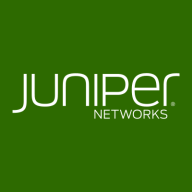

Cisco Catalyst Switches and Juniper QFX Series Switches compete in the enterprise-grade network switch category. Cisco Catalyst has an edge in feature variety and enterprise deployment suitability, while Juniper QFX offers a slight advantage in cost-effectiveness and port density.
Features: Cisco Catalyst Switches offer advanced security options, Power over Ethernet (PoE) capability, and network monitoring tools such as RSPAN. They allow for stacking, improving network availability, and support VLANs for effective network segmentation. The reliability in diverse environments is a key strength, ensuring they are fit for enterprise deployments. Juniper QFX Series Switches include high port density and low power consumption as standout features, with robust scalability options through EVPN-VXLAN, allowing for flexible network architectures.
Room for Improvement: Cisco Catalyst Switches face criticism over high pricing and a complex licensing model. The interface could be more user-friendly, and better third-party integrations could enhance utility. Additionally, limited expansion slots and outdated models can be concerning. Juniper QFX Series Switches could benefit from a more streamlined user interface and improved deployment features. More competitive pricing could increase their market adoption.
Ease Of Deployment and Customer Service: Cisco Catalyst Switches are recognized for their straightforward deployment and strong documentation, though technical support response times can vary. Juniper QFX Series Switches also facilitate reliable deployment, but their support could be more accessible for new users.
Pricing and ROI: Cisco Catalyst Switches are perceived as high-priced but valued for their performance and reliability, which many justify as a trade-off. While Juniper QFX Series Switches are expensive, they often offer more affordability than Cisco, appealing to budget-conscious businesses seeking good performance at competitive prices. Both deliver strong ROI but differ in initial cost and licensing complexities.
From an investment standpoint, deploying Cisco Catalyst Switches offers tangible benefits, including cost reductions.
The normal ROI customers work with is five years unless there is a major change in technology.
On a scale from one to 10, I would rate the technical support of Cisco at 10 out of 10.
Cisco's support is good, one of the best supports that you will get.
Cisco support is very good and responsive.
Sometimes parts are not available in stock, then you have to wait for replacement time.
The scalability of Cisco Catalyst Switches is very much scalable, as it supports the stacking feature and growth; for instance, with 94K modular switches, based on the requirement, we can even increase modules for more bandwidth.
Cisco Catalyst Switches are scalable, and I would rate them eight to nine out of ten for scalability.
When building a fabric, you can add multiple leaf switches and multiple spine switches if required.
Cisco Catalyst Switches are stable.
Juniper has better performance than any other networking product as far as performance is concerned in the router area.
Currently, I don't see much AI integration with Cisco Catalyst Switches; though they've started, it still needs improvement.
Cisco Catalyst Switches could be a little bit cheaper as they are very costly.
The configuration options on the Cisco Commerce website could be more efficient.
My personal opinion is that if anyone wants to work with a Layer 3 fabric in a data center, they should choose Juniper because working with ACI and APIC is very complex in the Cisco part.
Cisco provides unique features that justify their pricing.
Cisco usually is costly compared to other vendors.
Cisco Catalyst Switches are quite pricey.
We are a number one, tier-one partner of Juniper. Therefore, we normally get better discounts than with Cisco because we don't have the level one partnership with Cisco.
Cisco Catalyst Switches are valuable for their reliability and performance.
The most beneficial features for our network management are their stability and good customer support.
Catalyst Switches are efficient and swift, which is valuable for my organization.
They work with EVPN solutions, providing a Layer 3 fabric, which is a very good capability.
| Product | Market Share (%) |
|---|---|
| Cisco Catalyst Switches | 3.0% |
| Juniper QFX Series Switches | 0.4% |
| Other | 96.6% |


| Company Size | Count |
|---|---|
| Small Business | 78 |
| Midsize Enterprise | 29 |
| Large Enterprise | 78 |
| Company Size | Count |
|---|---|
| Small Business | 4 |
| Midsize Enterprise | 1 |
| Large Enterprise | 2 |
Cisco Catalyst Switches are a reliable and scalable network switching and routing solution, focusing on VLANs and VLAN switching. They are used as access switches, distribution switches, and core switches in various environments, deployed on-premises, and used for long connections. The switches are easy to configure, install, and upgrade and offer good pricing.
The most valuable features include warranty and firmware support, stability, security, good performance, flexibility, etc. The Cisco Catalyst Switches have provided a stable solution for the organizations and are widely used, trusted, and well-known in the networking industry.
QFX Series Switches deliver industry-leading throughput and scalability, an extensive routing stack, the open programmability of the Junos OS, and a broad set of EVPN-VXLAN and IP fabric capabilities. With QFX, you’ll find premier solutions for data center spine-and-leaf, campus distribution, core, and data center gateway and interconnect switching.
Rethink data center operations and fabric management with turnkey Juniper Apstra software in your QFX Series environment. You can automate the entire network lifecycle to simplify design and deployment and provide closed-loop assurance. With Apstra, customers have achieved 90% faster time to deployment, 70% faster time to resolution, and 83% OpEx reduction.
We monitor all Ethernet Switches reviews to prevent fraudulent reviews and keep review quality high. We do not post reviews by company employees or direct competitors. We validate each review for authenticity via cross-reference with LinkedIn, and personal follow-up with the reviewer when necessary.